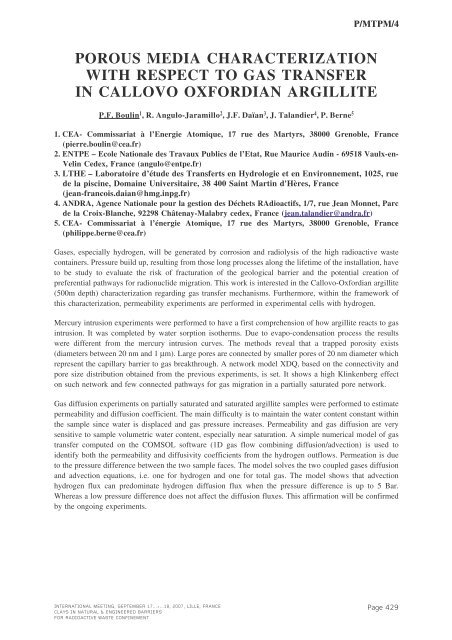Mass Transfer & Porous Media (MTPM) - Andra
Mass Transfer & Porous Media (MTPM) - Andra
Mass Transfer & Porous Media (MTPM) - Andra
Create successful ePaper yourself
Turn your PDF publications into a flip-book with our unique Google optimized e-Paper software.
P/<strong>MTPM</strong>/4POROUS MEDIA CHARACTERIZATIONWITH RESPECT TO GAS TRANSFERIN CALLOVO OXFORDIAN ARGILLITEP.F. Boulin 1 , R. Angulo-Jaramillo 2 , J.F. Daïan 3 , J. Talandier 4 , P. Berne 51. CEA- Commissariat à l’Energie Atomique, 17 rue des Martyrs, 38000 Grenoble, France(pierre.boulin@cea.fr)2. ENTPE – Ecole Nationale des Travaux Publics de l’Etat, Rue Maurice Audin - 69518 Vaulx-en-Velin Cedex, France (angulo@entpe.fr)3. LTHE – Laboratoire d’étude des <strong>Transfer</strong>ts en Hydrologie et en Environnement, 1025, ruede la piscine, Domaine Universitaire, 38 400 Saint Martin d'Hères, France(jean-francois.daian@hmg.inpg.fr)4. ANDRA, Agence Nationale pour la gestion des Déchets RAdioactifs, 1/7, rue Jean Monnet, Parcde la Croix-Blanche, 92298 Châtenay-Malabry cedex, France ( jean.talandier@andra.fr )5. CEA- Commissariat à l’énergie Atomique, 17 rue des Martyrs, 38000 Grenoble, France(philippe.berne@cea.fr)Gases, especially hydrogen, will be generated by corrosion and radiolysis of the high radioactive wastecontainers. Pressure build up, resulting from those long processes along the lifetime of the installation, haveto be study to evaluate the risk of fracturation of the geological barrier and the potential creation ofpreferential pathways for radionuclide migration. This work is interested in the Callovo-Oxfordian argillite(500m depth) characterization regarding gas transfer mechanisms. Furthermore, within the framework ofthis characterization, permeability experiments are performed in experimental cells with hydrogen.Mercury intrusion experiments were performed to have a first comprehension of how argillite reacts to gasintrusion. It was completed by water sorption isotherms. Due to evapo-condensation process the resultswere different from the mercury intrusion curves. The methods reveal that a trapped porosity exists(diameters between 20 nm and 1 µ m). Large pores are connected by smaller pores of 20 nm diameter whichrepresent the capillary barrier to gas breakthrough. A network model XDQ, based on the connectivity andpore size distribution obtained from the previous experiments, is set. It shows a high Klinkenberg effecton such network and few connected pathways for gas migration in a partially saturated pore network.Gas diffusion experiments on partially saturated and saturated argillite samples were performed to estimatepermeability and diffusion coefficient. The main difficulty is to maintain the water content constant withinthe sample since water is displaced and gas pressure increases. Permeability and gas diffusion are verysensitive to sample volumetric water content, especially near saturation. A simple numerical model of gastransfer computed on the COMSOL software (1D gas flow combining diffusion/advection) is used toidentify both the permeability and diffusivity coefficients from the hydrogen outflows. Permeation is dueto the pressure difference between the two sample faces. The model solves the two coupled gases diffusionand advection equations, i.e. one for hydrogen and one for total gas. The model shows that advectionhydrogen flux can predominate hydrogen diffusion flux when the pressure difference is up to 5 Bar.Whereas a low pressure difference does not affect the diffusion fluxes. This affirmation will be confirmedby the ongoing experiments.INTERNATIONAL MEETING, SEPTEMBER 17...>...18, 2007, LILLE, FRANCECLAYS IN NATURAL & ENGINEERED BARRIERSFOR RADIOACTIVE WASTE CONFINEMENTPage 429
















